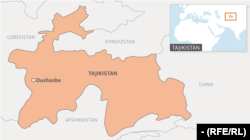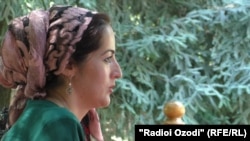DUSHANBE -- Dildora, a 30-year-old Tajik mother in Dushanbe, had taken her children to see a doctor at a medical clinic near her home in early August when she was approached by a small team of state officials.
The authorities questioned her about her apparel -- an Islamic hijab, tied under her chin and over the front of her neck -- that is known as a satr.
Although there are no laws against wearing a hijab in Tajikistan, Dildora says the officials told her she could be fined for wearing her head scarf in an "alien" fashion.
Dildora says she and other hijab-clad women at the clinic were separated from their children and herded into a room where they were lectured on how to tie their head scarves in the style of "traditional national clothing" -- that is, with a knot behind their heads in a way that exposes the front of their necks.
"Security officers, one man and two women, were among them," Dildora told RFE/RL. "They forced us to take off our satrs and showed us how we must wear hijabs."
"They told us to wear national clothing only," said Dildora, who has worn the hijab since finishing her education at a madrasah, an Islamic religious school, 12 years ago. "I challenged them, asking the women police officers why they wore Western trousers and did not cover their heads. We exchanged many words."
"Everything was filmed and photographed," Dildora said, adding that the confrontation was so intimidating she no longer goes out in public unless it is absolutely necessary.
Religion Control
Dildora was among some 8,000 women approached by authorities in Dushanbe in early August as part of a state campaign to discourage what the government calls "nontraditional" foreign clothing.
Human rights activists say the government uses the term "nontraditional dress" as a euphemism for the Islamic hijab.
Indeed, Dushanbe's fashion patrols only targeted the women in Islamic garb that they came across in public places like parks, markets, or state institutions like Dildora's local medical clinic.
A U.S. State Department report on religious freedom this week noted numerous cases since May 2016 in which hijab-wearing Tajik women say they have been harassed by authorities.
The report confirmed that U.S. diplomats have raised concerns with Tajikistan's government about its harassment of women in Islamic clothing.
It also raised concerns about the government's attempts to control all aspects of religious life in the country -- including the approval and registration of religions, the construction of places of worship, the distribution of religious literature, and religious education for children.
About 90 percent of Tajikistan's 8.3 million citizens are Muslims, and the majority are followers of the moderate Hanafi school of Sunni Islam.
About 4 percent of the country's Muslims are Ismaili Shi'a. Most of that minority community live in the mountainous Gorno-Badakhshan Autonomous Region that borders Afghanistan.
The Tajik Constitution says citizens have the right to adhere to any religion, or to no religion at all, and to observe religious customs and ceremonies.
It also says religious organizations must be separate from the state and cannot interfere in "state affairs."
A May 2016 constitutional amendment bans political parties that are based on religion. That law led to the controversial dissolution of the Islamic Renaissance Party of Tajikistan, an opposition party, and the arrest of several of its leaders.
Tajikistan's laws also restrict the locations of Islamic prayer and prohibit children under the age of 18 from taking part in public religious activities.
The government argues that its strict controls on religion are necessary to prevent the growth of what it calls Islamic "extremist" organizations and terrorist groups.
But the U.S. State Department report says Dushanbe's controls over religious life also cause problems for minority communities of Jehovah's Witnesses, Baptist Christians, Russian Orthodox Christians, Roman Catholics, Ismaili Shi'a, and Jews.
Fashion Police
Marhabo Olimi, deputy chairwoman of the government's Committee on Women's Affairs, told RFE/RL that the government's August campaign to "promote traditional national dress" employed small "working groups" of state agents from her committee, Tajikistan's Interior Ministry, the Committee on Religious Affairs, and other government departments.
Olimi said more than 90 percent of the women confronted by the patrol teams "confessed they were being forced" to wear Islamic clothing by their husbands or by adult male relatives.
She said many of those women told authorities they would agree to remove their hijabs if their husbands and other relatives allowed them to do so.
"We should conduct explanatory work among men," Olimi told RFE/RL. "After all, no one in the government is telling them that their wives or daughters should walk around in public without a head scarf. But we've become aware of cases where husbands who work in Russia are telephoning their wives and threatening them with divorce if they refuse to wear the hijab."
But Zebo, another young woman from Dushanbe who wears the hijab, told RFE/RL a different story in the midst of the government's early August campaign.
"It is my decision to wear satr," Zebo told RFE/RL. "I do this hoping that it will be taken into account after my death. When a woman wears satr, such a woman is greeted with expressions of respect. If a law banning the satr is accepted, I will be frustrated. I have been wearing satr since my childhood. They must not violate our rights."
In fact, the U.S. State Department has named Tajikistan as a "country of particular concern" under the International Religious Freedom Act of 1998, saying it has "engaged in or tolerated particularly severe violations of religious freedom."
But Washington has waived the sanctions that normally go with the designation, justifying the decision on the grounds that Tajikistan's efforts to combat Islamic terrorism is "in the important national interest of the United States."
Religious groups banned in Tajikistan as "extremist" organizations include Salafis, the Muslim Brotherhood, the Islamic Movement of Uzbekistan, Islamic State militants, Jindullah, Ansarrullah, and Hizb ut-Tahrir.
Sharif Nazarzoda, head of the Sughd Regional Department of Tajikistan's Interior Ministry, has insisted that "some women and girls" associated with extremist "terrorist" organizations can be identified because they follow "alien culture and traditions."
Nazarzoda also has said that Interior Ministry police will detain women in hijabs in order to investigate whether their husbands are "militant Salafists."
He says that practice is justified because the ministry has determined that "all Salafist wives wear hijabs."
Tajik authorities also have closed down scores of shops that sell women's religious clothing that does not meet what the government calls "national traditions."
Despite complaints by many woman of state harassment, Tajik Interior Ministry spokesman Umarjoni Emomali told RFE/RL that women who wear hijabs are not being threatened with fines or arrest.
"There are no fines for this," Emomali said. "What we are conducting now are explanatory talks. The authorities are merely reminding women that wearing hijabs, satrs, and turbans is alien to the traditions of the Tajik people."









